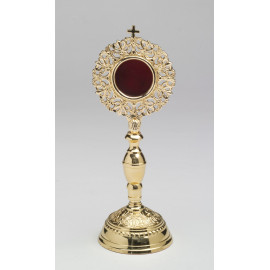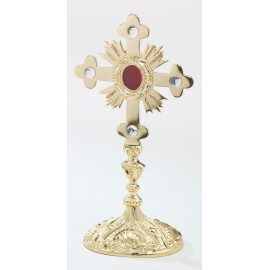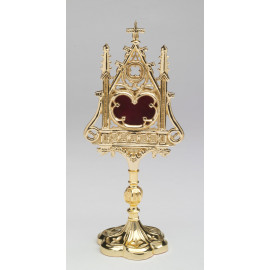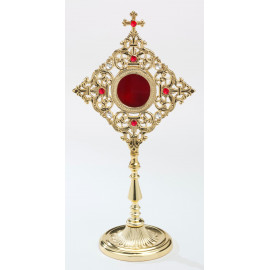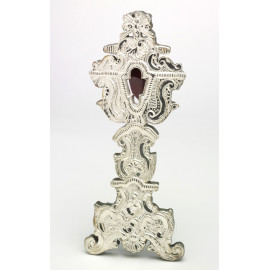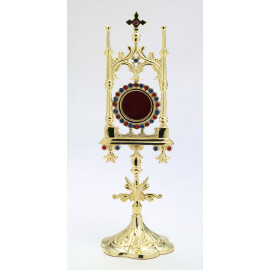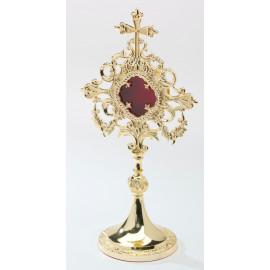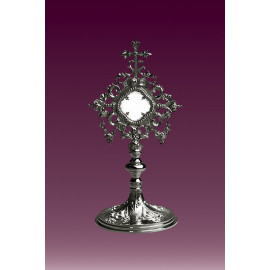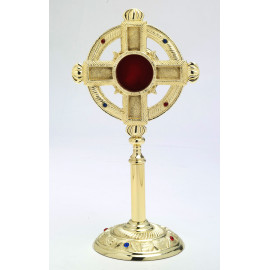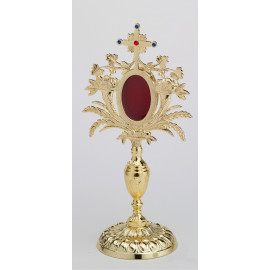No products
Product successfully added to your shopping cart
There are 0 items in your cart. There is 1 item in your cart.
Reliquaries
- Altar Bell and Gong
- Candle Snuffer
- Candlestick
- Catholic Pyx
- Chalices
- Church wall lamps
- Ciborium
- Crosses and Crucifix
- Cruets & Trays
- Holy Water Font
- Holy Water Pot
- Missal Stand
- Monstrance Tabor
- Monstrances
- Offering Baskets
- Oil Stock
- Patens
- Reliquaries
- Sanctuary Bells
- Sanctuary Lamp
- Sprinkler
- Thurible, Boat, & Spoon
- Travel Liturgy & Mass Kit
A reliquary is a container used to hold and display sacred relics, which may be the physical remains of saints, such as bones, pieces of clothing, or other objects. The term "reliquary" is derived from the Latin word "reliquiae," which means "remains". Reliquaries are used in many religions, including Christianity, Buddhism, and Hinduism, and are often presented in shrines, churches, or temples to which the faithful make pilgrimages to gain blessings. In Christianity, the use of reliquaries became an important part of Christian practices from at least the 4th century, initially in the Eastern Churches, which adopted the practice of moving and dividing the bodies of saints much earlier than the West. Relics are venerated in the Oriental Orthodox, Eastern Orthodox, Roman Catholic, and some Anglican Churches. Reliquaries provide a means of protecting and displaying relics, and while frequently taking the form of caskets, they range in size from simple pendants or rings to very elaborate ossuaries.
A reliquary is a container used to hold and display sacred relics, which may be the physical remains of saints, such as bones, pieces of clothing, or other objects. The term "reliquary" is derived from the Latin word "reliquiae," which means "remains". Reliquaries are used in many religions, including Christianity, Buddhism, and Hinduism, and are often presented in shrines, churches, or temples to which the faithful make pilgrimages to gain blessings. In Christianity, the use of reliquaries became an important part of Christian practices from at least the 4th century, initially in the Eastern Churches, which adopted the practice of moving and dividing the bodies of saints much earlier than the West. Relics are venerated in the Oriental Orthodox, Eastern Orthodox, Roman Catholic, and some Anglican Churches. Reliquaries provide a means of protecting and displaying relics, and while frequently taking the form of caskets, they range in size from simple pendants or rings to very elaborate ossuaries.
Reliquaries There are 42 products.
Understanding the Church Reliquary
A church reliquary is a sacred container that plays a pivotal role in many religious traditions, particularly within Christianity.
These ornate vessels are designed to house and protect the physical remnants of saints, known as relics, which may include bones, clothing, or other objects associated with holy figures.
The presence of a reliquary within a church not only serves as a focal point for veneration but also connects the faithful to the divine through the physical remnants of those who have led exemplary lives of faith.
The Historical Significance of Reliquaries
The tradition of venerating relics and housing them in reliquaries dates back to the early days of Christianity.
In the fourth century, as Christianity became more widespread, the practice of preserving and honoring the remains of saints and martyrs gained prominence.
Church reliquaries became repositories of these holy items, often becoming as revered as the relics they contained.
Throughout the Middle Ages, reliquaries were crafted with the utmost artistry, often adorned with gold, silver, and precious stones, reflecting the sacred value of their contents.
The Role of Reliquaries in Worship and Pilgrimage
Church reliquaries are not merely decorative; they serve a profound purpose in religious life.
They are often placed on altars or in special chapels within churches, becoming centers of prayer and reflection.
Many believers embark on pilgrimages to visit these reliquaries, seeking blessings, healing, or spiritual guidance.
The act of venerating a reliquary is seen as a way to forge a closer connection with the divine and the saints who have gone before, bridging the gap between heaven and earth.
The Artistry and Craftsmanship of Reliquaries
Creating a church reliquary is a sacred art form that requires skill and devotion.
Artisans who create these vessels are not just craftsmen; they are storytellers who encapsulate the life and virtues of the saints within their work.
The design of a reliquary often reflects the saint's identity or the nature of the relic it holds.
For instance, a reliquary containing a fragment of the True Cross might be shaped like a cross itself, while one holding a saint's finger bone might take the form of an ornate hand.
FAQs About Church Reliquaries
What is a church reliquary?
A church reliquary is a specially designed container used to store and display sacred relics, which are physical remains or personal effects of saints and religious figures.
Why are reliquaries important in churches?
Reliquaries are important because they provide a tangible connection to the holy individuals who have significantly impacted the faith. They serve as focal points for worship and are often associated with miraculous events and healing.
How are relics obtained for a reliquary?
Relics are typically obtained through the church hierarchy and are often accompanied by documentation certifying their authenticity. They may be gifts from other churches, discovered during excavations, or passed down through generations.
Can anyone create a reliquary?
While anyone with the necessary artistic skills can technically create a reliquary, the commissioning and blessing of a reliquary for liturgical use is usually done through official church channels to ensure its appropriateness and sanctity.
Are all reliquaries made of precious materials?
Not all reliquaries are made of precious materials. While many are crafted from gold, silver, and adorned with gems, others may be made from more humble materials but are still treated with great reverence due to their sacred contents.
In conclusion, a church reliquary is a profound symbol of faith, artistry, and history, serving as a bridge between the physical and the divine. Its presence in a church is a testament to the enduring human desire to connect with the sacred and to honor those who have exemplified a life of holiness.

